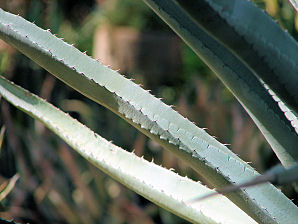Xeriscape Landscape Plants & Flowers
For The Arizona Desert Environment.
Pictures, Photos, Images, Descriptions, & Reviews.
Palmer's Agave, Agave palmeri.
We Are Proud Of Our SafeSurf Rating!
Click On Any Of The Following Links By Amazon.Com
For Books, & Videos About Wildflowers Of Arizona & The Southwest USA. No Obligation!
 |
| Palmer's Agave, Agave palmeri. Desert Botanical Garden of Phoenix, Arizona, October 6, 2006. |
|---|
 | |
| Palmers Agave, Agave palmeri. | Palmer's Agave, Agave palmeri. |
|---|
Palmer's Agave.
We wish to thank Wikipedia, the free encyclopedia for some of the information on this page. We share images and information with Wikipedia. The Agave palmeri basal rosette is composed of many narrow, grey - blue green leaves, 36 - 48 inches long. The edges of the leaves have short, dark brown, serrated thorns and the tip has a thick, white - brown thorn of about 1 1/4 inches. The inflorescence is made up of a 6 foot stem with lateral branches holding groups of violet - green flowers. Often after the flowering there appear �pups�( already formed tiny plants) which fall to the ground, giving life to a new colony of Agaves. Agave palmeri grows in arid to semi-arid upland chaparral and Pinion-Oak woodland at elevations of about 3,000 to 6,500 feet, ranging from northwestern Mexico through south central Arizona. One extreme northwestern limited population is in the northern Baboquivari Mountains, about 45 miles southwest of Tucson. You can see some natural populations at Kitt Peak, Arizona. Agave palmeri is one of a few plants in Mexico used to make mezcal. Technically, tequila is a type of mezcal, however all mezcals are not tequila. To be a true tequila, it must be derived from Agave tequilana Weber azul, or more commonly known as the Webers Blue variety of Agave tequilana.The tequila also must be produced in the Mexican state of Jalisco, in the town of Tequila. We have been to Tequila and you can smell the fermenting for several miles away. Mezcal is made from one of 5 or 6 species of Agave. Agave parryi var. truncata, is one used for mescal, not tequila. There is a black market Mezcal production going on in northern Mexico and southern Arizona that is a threat to this plant.
Quick Notes:
Height: Dense rosette, 3 - 4 feet tall, and 3 to 4 feet in diameter.
Flowers: A large stalk emerges from the center of the plant, it becomes about 15 feet tall. Then, gold yellow flowers grow from the stalk. It will die after flowering and will need to be replaced.
Flowering Time: Phoenix Arizona, January - August.
Leaves: The leaves are blue - gray about 3 - 4 foot long by about 4 - 5 inches across. The leaf margins have dark brown teeth that are curved back towards the base of the plant.
Found: Native of southeastern Arizona, New Mexico, & northern Mexico (Sonora, Chihuahua).. The USDA also claims it is native of the USA (AZ).
Hardiness: Hardy to about 5� F. USDA Zone 7b, judging by where it grows naturally.
Soil pH requirements:
Sun Exposure:
Elevation: Native at 3,000 - 6,500 feet. In Southern Arizona.
Habitat: It grows well in sand, sandy loam. It needs good drainage and aeration. It is remarkably tolerant of alkali. Naturally found on dry, rocky slopes and flats
Miscellaneous: Maintenance: Low. Photos Taken; Desert Botanical Garden of Phoenix Arizona, October 6, 2006.
|
We Are Proud Of Our SafeSurf Rating!
Click On Any Of The Following Links By Amazon.Com
For Books, & Videos About Wildflowers Of Arizona & The Southwest USA. No Obligation!
| © 1966 - Present, Audrey, Eve, & George DeLange |
